The Chadar Trek is undoubtedly one of our favourite Himalayan treks. The first time we heard about Chadar Frozen River Trek in Ladakh, we were intrigued. When I came to know about the conditions in which we have to trek, I was a bit sceptical. Just imagine walking on a frozen river for almost 8 hours a day at an altitude of almost 11,000 feet. And did I mention the temperature? It is always below zero ranging between -5 to -35 degrees. Not inviting at all! I was finally convinced and we successfully completed the trek; but not without a few hiccups. So here we share our experience on Chadar Trek and a few tips to plan Chadar Trek.

Chadar Frozen River Trek | Chadar Trek
Chadar TrekTrek is considered one of the toughest treks in India. After all, you have to walk over a river, sleep on ice and might even have to wade through knee-deep ice cold water! I will not call it glamorous as many tend to call it; simply because, when Chadar Trek is associated with the word ‘glamorous’, it becomes one that needs to be ticked off the long ‘glamorous’ list. The Chadar Frozen River Trek is an experience, a feeling of wonder. We had done this trek long back in January 2014 – a time when there was not much rush of trekkers at Leh. Chadar Frozen River Trek was our second Himalayan Trek after Roopkund Trek the year before. While Roopkund made us fall in love with trekking, Chadar Trek made us understand the responsibility of being a better trekker or traveller.

What is Chadar Trek?
I always say that Ladakh is a place that never fails to awe its visitors. During the summers, Ladakh is vibrant with all the colours and sound of life. The same place bears a desolate and bleak look during the winter months. It is almost cut off from the rest of the world during this time and almost all the passes connecting Leh are closed due to heavy snowfall. The only way you enter Leh is by flight! Some of the villages become inaccessible during the winters due to snow and one can reach such village by trekking through frozen rivers!!!
The Zanskar River is a wild river gushing through the ravines and treacherous canyons of Ladakh. During the summers, the mighty river flows with all its fervour. But, during the winters, the river freezes and calms down. A blanket of ice forms over the river – thus letting the locals who are trapped in the inaccessible Zanskar villages walk over it and reach towards civilization in case of exigencies. This frozen blanket or “Chadar” (Chadar literally means blanket) is the only way in and out for the Zanskari villagers in winter.
The temperature during this time can be as low as -10 degrees in the morning and -25 to -30 degrees in the evening! A seven to eight days hike in inhospitable conditions over the river would take you from Padum, capital of Zanskar valley to Chilling, near Leh. The Chadar Trek, according to me is not just a trek; it is a symbol of hope and optimism. It signifies the indomitable spirit and courage of the people of the region.
Is Chadar Trek or Chadar Frozen River Trek Difficult?

Chadar Trek, as such, does not have a difficult trail. Yes, I repeat it again – the trail is not difficult, but it is definitely tricky. There are not much ascents and descents as you have in other treks. But, negotiating your way over a thin layer of ice over a fast-flowing blue river is no mean feat. The sub-zero temperature also does not help much. At Chadar, it is a constant fight of willpower to carry on with the trek!
For the trekkers, the Chadar Frozen River trek starts from Chilling, a few kilometres ahead of the Zanskar-Indus Sangam point and leads through the narrow canyons of the Zanskar valley. The trek ends at the Nerak village.
Chadar Trek – an unforgettable experience

Time spent on the Chadar Trek was surely an unforgettable experience. At one time, we were simply awed by the splendour and magnificence of nature. The breathtaking views of golden mountains, frozen waterfalls, hanging icicles the babble of river few inches below our feet simply mesmerized us.
On the other hand, we were also trying hard to cope with the harsh conditions of the terrain. For city folks like us where the temperature in summer goes as high as 40 degrees, trekking at sub-zero temperature is difficult. There were times when we were actually cursing ourselves as to why we are enduring such difficulty!
The first couple of days were really difficult for us. The chilly winds seemed to freeze us to the bones. As long as there was sunshine above us, all was well. As soon as we entered a shadow area, the biting cold returned.
Mornings in Chadar Trek

Early morning at the Chadar Trek made us feel that we were inside a refrigerator. At night, we slept inside 2 sleeping bags and covered ourselves fully. I did not cover my nose and mouth while slepping, because I feel nauseated if I do so. When I used to wake up in the morning, I would find ice frozen on my hair and top of my nose. After waking up, my hands and feet used to go numb totally. The only therapy there was to walk and walk fast until our feet responded again. Well, going for daily ablutions was also quite a pain. But this is something that cannot be avoided! So I just used to clench my teeth and go towards the toilet! Phew, it was really some experience.
Gradually, as a couple of days passed, we started getting a hold of the Chadar. We started understanding the place and the terrain. The sound of the flowing rivers underneath our feet sounded like music to our ears. The sound of the flowing river changes according to the thickness of the Chadar or ice blanket. The guides have great knowledge about this and by the sound of the river, they can predict quite accurately whether it is safe to move on that patch of ice. Finally, we also started mastering the technique to walk over the ice. One needs to walk like a penguin-like stance on the ice so as to not slip and fall.
Chadar Trek | Walking over Ice
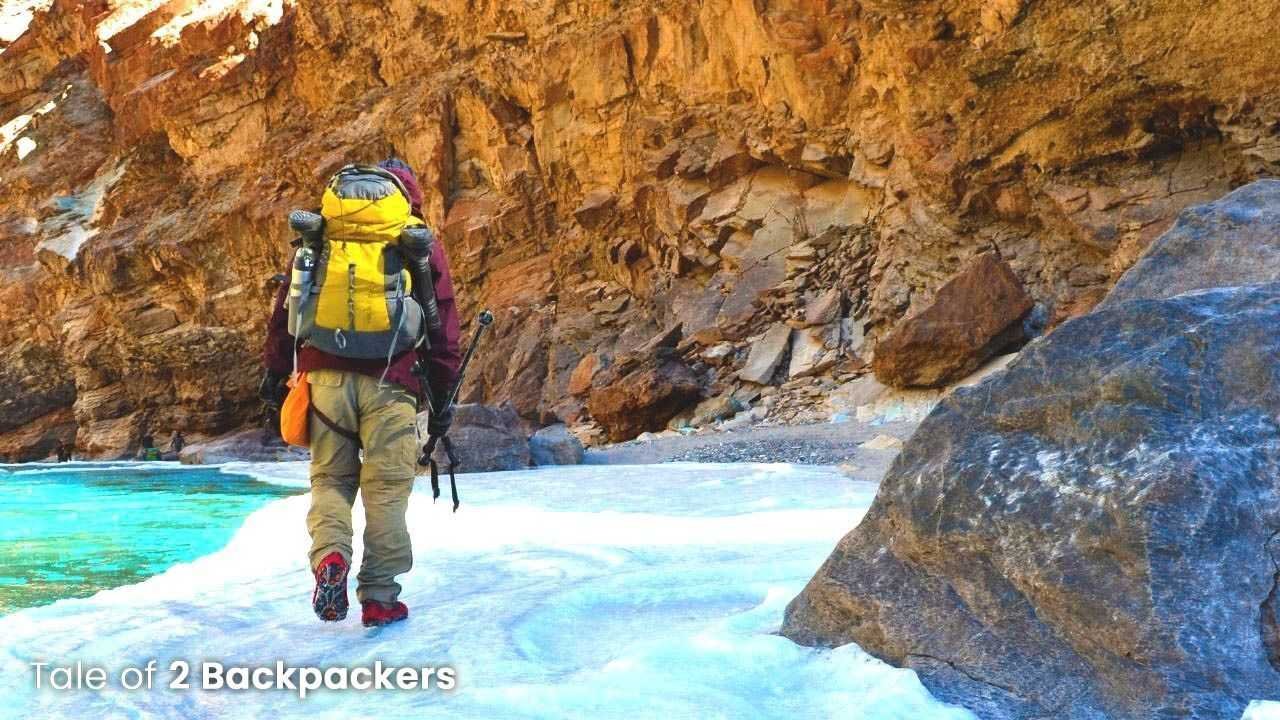
The entire trail path of Chadar Trek might not be uniform. At places, we found fresh snow, while at other places we had to tread on hard ice. Walking on soft snow is relatively easy than walking on hard iceAs I mentioned before, we had to walk slowly in a penguin kind of way. On the first few days, we lost count the number of times we fell down while walking. Gradually, we started walking in the perfect way. Experienced trekkers, as well as the locals, fall down on hard ice. The only thing you do in such situation is to rise again and start walking again with the same zeal and spirit.
You might be given crampons to walk over the ice. It will definitely make your walk easier, but it is not good for the ice blanket. The pressure of the crampons breaks the ice easily.
And at some places, there was no ice blanket at all. It is broken, weak or not formed. The river flowed with all its might!! Here we had only 2 options – either we made our way through the chilling water. Gumboots came handy during this time. Or if the water was quite deep, we had to climb over the mountains to cross the broken Chadar. What an experience it was!
Evening and nights at Chadar Trek was always beside the campfire trying to warm ourselves. We always used to have an early dinner and go off to sleep early. But the campsites below the clear starry skies were a beauty to reckon. Those were some of the best starry skies I had seen.
Chadar Trek campsites
Chadar Trek boasts of some very difficult campsites. The locals usually stay at the caves during the night. If you are going with some trekking agency, you might be provided with tents. Personally, our favourite campsite is the Shingra Koma campsite. It is a big campsite beside a frozen stream. As you walk down the stream exploring, you will encounter a frozen waterfall. The whole place will look as if straight out of some Hollywood movie.
Chadar Frozen River Trek route
Leh is the basecamp of the Chadar Frozen River Trek. Tilat Sumdo is the first campsite for the trek. But once you arrive at Leh, please spend at least 2-3 days for acclimatization. In the winter months, you have to fly into Leh. So acclimatization becomes even more important. Spend these 2-3 days doing nothing. Acclimatization is very very important to prevent AMS.
Chadar Trek starts and ends at the same point. And on the way, we encountered ice sheets, countless frozen waterfalls and all the wonders of nature. The route we followed for the trek:
Leh – Tilat Sumdo – Shingra Koma – Tibb – Nerak – Tibb – Shingra Koma – Tilat Sumdo – Leh
Day 1,2 & 3: Leh (11,400 ft)

After arriving at Leh, we stayed at Leh for 3 days to acclimatize. The first 2 days, we confined ourselves to the hotel and only roamed a little on the streets of Leh. On the third day, we visited the Shanti Stupa in the evening.
This rest for 3 days is required. And I will keep on reiterating this, AMS and acclimatisation throughout this blog.
Day 4: Leh – Tilat Sumdo (10,390 ft)

We started from Leh by road and arrived at Chilling. On the way, we stopped at Nimoo, the confluence of the Zanskar and Indus River. The rivers were frozen during this time. It looked so different from the time we had visited earlier during August. From Chilling, we had to climb down to the river bed. The place is known as Tilat Sumdo. It was our campsite for the night.
We reached at Tilat Sumdo in the afternoon. Once we were there, it was the time to get acquainted with our fellow trek mates. Our trek leader briefed us about what lay ahead of us for the next 8-9 days. We also took an acclimatisation walk on the icy river bed. Our trek leader showed us how to walk on thick hard ice. It was difficult for the first time. I kept on falling down. But the others encouraged me to again get up and walk. I guess that day the number of times I fell down in one day exceeded that of my entire life till that day!
After all the fun of walking and falling, our trek leader called it a day early so that we could get a nice rest. “The real fun starts tomorrow”, he grinned at us.
Day 5: Tilat Sumdo – Shingra Koma (10,550 ft, 10 km)

The next day, we started our trek from Tilat Sumdo to Shingra Koma, which is about 10 km away. The walk was not easy. We had to walk in the penguin kind of way. And of course, pay heed to our guides. They know the region the best.
Day 6: Shingra Koma – Tibb (10,760 ft, 14 km)
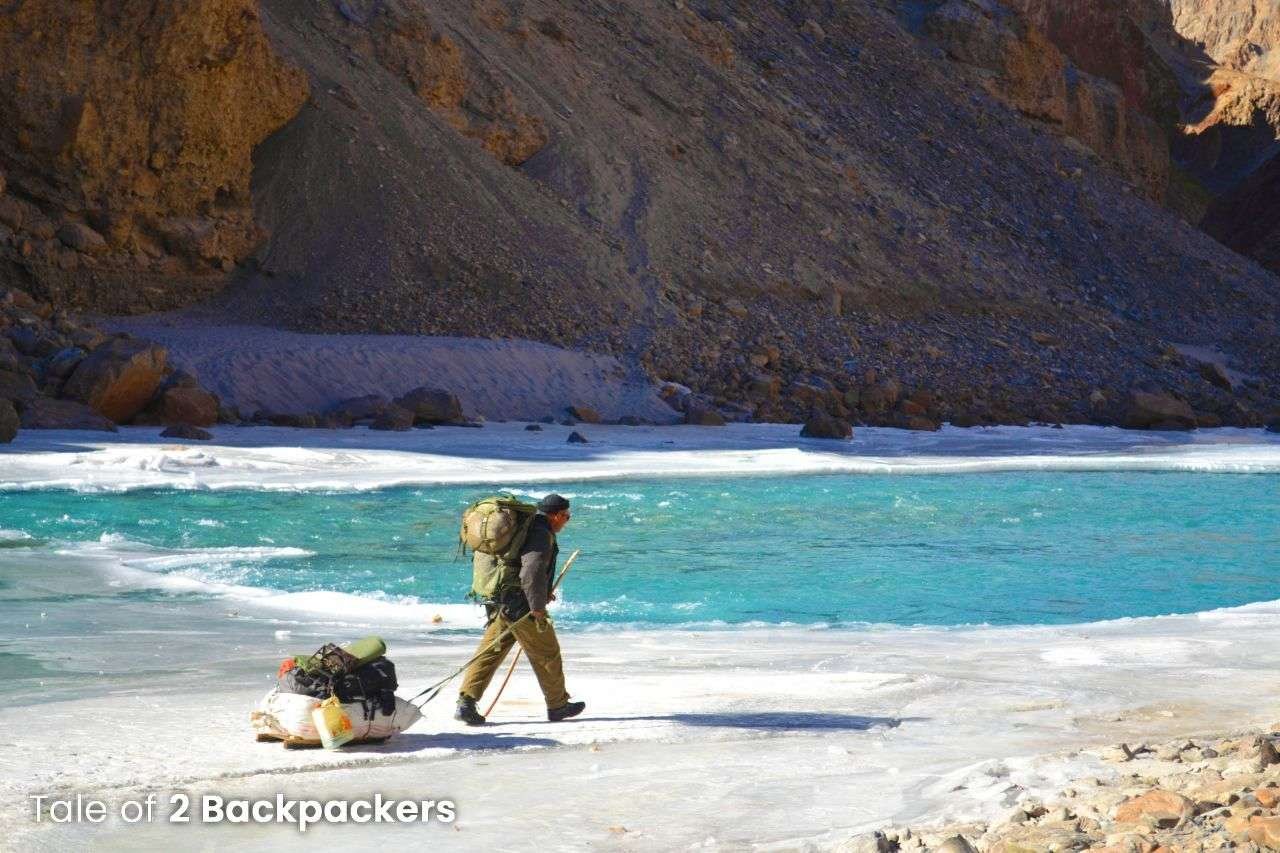
The biggest challenge this day was to wake up early in the morning and get ready for the day’s trek. It was so cold! All my hands and feet were numb. It was actually a great pain to go to the toilet and then get ready for the trek.
It was a long day of the trek and it took us about 6 to 7 hours to reach Tibb. We started by 8 AM and walked over the ice blanket. The sun, as usual, played hide and seek with us. Just as the sun god hid behind the clouds, we could feel the cold. As we trekked, we simply wandered at the splendour of nature all around us. The ochre mountains on both sides looked like canyons and the frozen waterfalls on them left a confound impression on us. It was something that I would never forget. On the way, we even came across the paw marks of snow leopards. Finally, by afternoon we reached our campsite at Tibb. There is a cave there where the locals usually stay for the night. We, however, stayed at tents.
Day 7: Tibb – Nerak (11,150 ft, 12 km) | Which did not happen

Yes, we could not continue our way to Nerak this day, we started as usual after fighting off with the cold. We went along quite a long way when our trek leader stopped us. Apparently, the ice blanket had broken at one of the places and the water was also quite deep. By this time, we already had waded through knee-deep water wearing our gumboots. But here the water was quite deep. After deliberating some time, it was decided that we would climb up the mountain-side and cross the water part.
Well, this was also not an easy task. The mountain trail was gravelly with loose stones and gravels. And it was definitely steep. Just a miscalculation of steps and I would fall deep down in the water. I saw many of my teammates took the trail and went on to the other side. When my turn came, I took the names of all the Gods I remembered. I was scared. Very scared. I did not want to fall down to the water.

I started slowly treading my way through the trail made for the trekkers. There were tricky parts where Agni and my team leader helped me negotiate. At one moment, I felt that I would simply fall down. But finally I managed to cross the patch. And yes, I was quite happy at the feat. But at the same time, a thought lurked behind my mind. I was now apprehensive about how many such trails we have to cross. Nevertheless, we started again.
After about an hour of trek, we stopped again. This time also, the blanket was broken and the water was too deep to wade through. One of the guides went ahead to see the path ahead. He back with a bad news. He informed us that the path beyond was broken totally. Even if we managed to cross this stretch, we would not be able to do it further.
It was time for a decision. Our team leader decided not to go further and we camped there for the night. It was decided by the guides and our leader that we would wait there for another full day. If the Chadar formed within this time, we would continue. Otherwise, we have to retrace our way. All of us prayed to whichever Gods we believed so that the ice blanket formed again. We did not want to return back after coming so close to the destination.
Day 8: Somewhere in between Tibb and Nerak (The Chadar did not form)
Well, the Chadar did not form even this day. So we used our spare day at the same place. If it did not form the next day, we were to return.
Day 9: To Nerak

Thankfully, the weather gods took pity on us and listened to our prayers. The ice blanket was formed and we started our trek again. We reached Nerak early. Nerak is known for the huge frozen waterfall. Next to the waterfall is a bridge that takes to Nerak village. We camped at Nerak for the night.
Day 10: Nerak – Tibb

We retraced our steps through the same trail. However, the trail was no longer the same. Well, the mountains were definitely at their place. But the ice blankets, river course changed. It felt as if we were trekking on a different route. That is the beauty of Chadar.
Day 11: Tibb – Shingra Koma
We followed the same way back.
Day 12: Shingra Koma – Tilat Sumdo – Leh
We trekked back to Tilat Sumdo and then returned to Leh by a car.
What is the best time for Chadar Trek?
Chadar trek completely depends on the ice blanket or Chadar formed on the Zanskar River. The best and only time that you can do this trek is between mid-January to mid-February.
Chadar Frozen River Trek | FAQs answered
Is the Chadar Trek difficult?
Yes, Chadar Trek is definitely a difficult high altitude trek. Physical fitness is absolutely essential for this trek and those suffering from asthma or other chronic diseases should not go for this trek.
What is the experience required for doing the Chadar Frozen River Trek?
You need to have done at least 4-5 Himalayan treks before you decide to do Chadar trek, out of them at least one should be a moderate one. The trekker must also have an experience of trekking more than 2500 m before. The trekking trail is not difficult per se, but the conditions of the trek are quite harsh. We would definitely not recommend first-timers to go for this trek.

When we went for the trek, we had already done 3 high altitude Himalayan treks. But we found that there were a couple of first-time trekkers too in a different group. The trek operators might allow a novice trekker to do Chadar trek for some income, but this is absolutely not the right thing. It is neither good for you and nor for Chadar.
What to pack for Chadar Trek?
Since you will be trekking in sub-zero temperature, clothing is very important. Layering is the mantra at Chadar trek. Wear layers of clothes. We usually wore our thermals inside, then a tee, a fleece and then our windproof jackets. Sometimes, I used to wear t tee-shirts. Here is a list of things that you need to pack for the trek.
- Warm clothes including fleece, heavy jackets and thermals.
- Gloves
- Balaclava and other woollen cap or scarf
- Several pairs of socks
- Good trekking shoes
- Gumboots to wade through the water parts
Other important things to carry for Chadar Trek:
- Trekking Pole
- UV-protected sunglasses
- Water bottles
- Thermal water bottles
- Hot water bags
- Headlamps and torches
- Basic medicine kit and toiletries
- Sunscreen
- Toilet Paper
How to reach Leh?

The only way to reach Leh during the winter is by flight. Leh Airport is connected with all the major airports of India. While on the flight, you can see the snow-covered mountain ranges and the Zanskar river from a height.
How will be mobile connectivity in the trek?
You will get BSNL connectivity in Leh. There will be no mobile connectivity during the trek.
How many days are required for the trek?
A total of 8-9 days are required for the trek. You will need 1 day to acclimatize and then another day for the medical checkup at the Government check-up centre. We would always recommend you to spend atleast 2 days for acclimatization to prevent AMS.

What is AMS?
AMS or Acute Mountain Sickness is actually the effect on the body at a higher altitude environment. AMS is quite common in higher altitudes, usually above 8000 ft. the occurrence of AMS depends on the altitude, the rate of ascent and individual susceptibility.
The symptoms of AMS are headache, dizziness, fatigue, shortness of breath, loss of appetite, nausea, disturbed sleep, and a general feeling of malaise. While trekking it is extremely important to look for the symptoms of AMS. And if you feel any of the above discomfort, you should immediately report to someone and see a doctor.
AMS can hit anyone at any time. Severe AMS has even taken life of even fit persons. So acclimatization is very important while you are in Leh, even if you come for a Ladakh trip.
If you experience the symptoms of AMS on your trek, please let others know. Do not ignore them. At such conditions, do not ascend further with the symptoms. Often Diamox is suggested as a preventive to AMS. Please consult with a physician before if you want to take it. Also, remember, Diamox is a preventive and not a curative drug. So you have to take it from before the start of the trek. There is no point in taking Diamox after you have AMS. There can be certain side effects of taking Diamox like frequent urination and tingling sensation in hand.
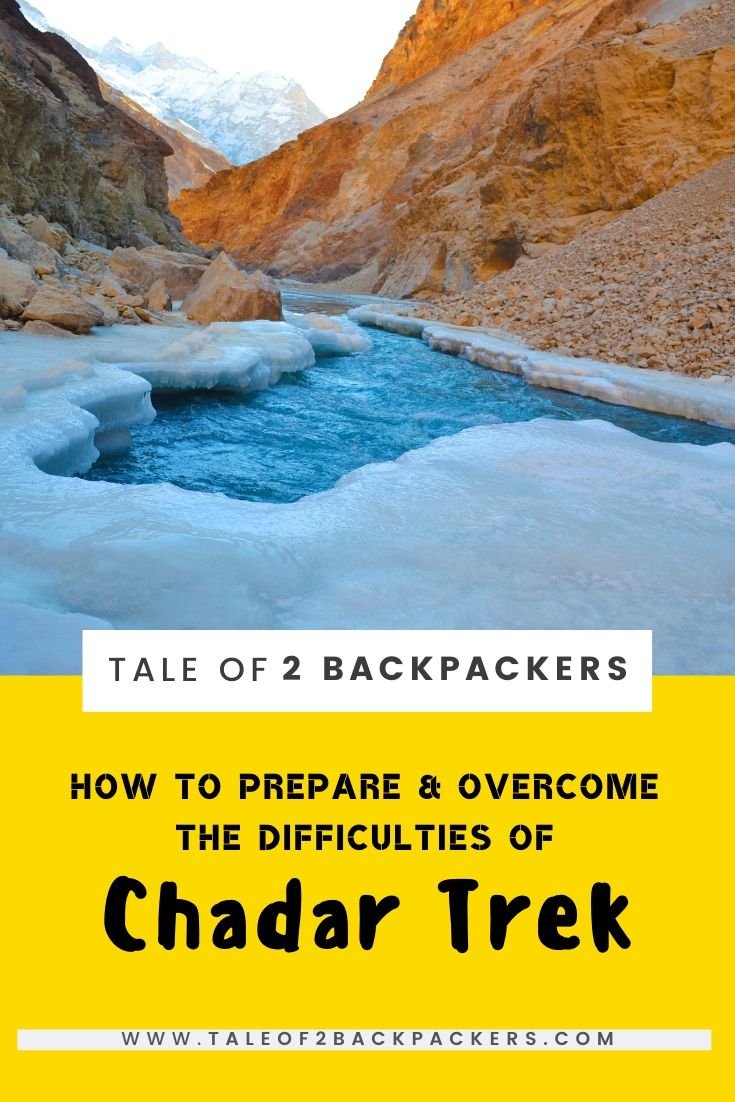
What is acclimatization?
During the peak season, when you can enter Leh by road, you can stop a night at a lower altitude (Kargil is usually suggested as a stop for the night before entering Leh). But during the winter months, you will be coming to Leh directly by flight. Delhi is at an altitude of 709 ft while Leh is 11,480 feet. There is such a gain in altitude within just a couple of hours. The body needs time to adjust to this change in altitude and so it is very important to stay at Leh for at least 2 days doing simply nothing. This process is known as acclimatization.
Responsible trekking at Chadar Trek

By now, you must have understood that the region has an extremely fragile environment and ecosystem.
The frozen Zanskar River offered a lifeline to the Zanskari villages to reach Leh, when snow closes all the land routes. The Chadar trek was their winter lifestyle. But with the popularity of this trek, also came a threat. During the last few years, the number of trekkers in Chadar increased exponentially. It had an adverse effect on the Chadar trail. With more trekkers walking on the ice blankets, it is creating a pressure on them and the blankets are broken.
Also the trekkers, guides and porters think little before littering the ice with garbage. Defecation also creates a problem in the higher altitudes. The normal decomposition process is already slower in the high altitudes. So it is not rocket science to understand that with so many trekkers, the toilet pits will become the breeding grounds of bacteria, which would ultimately contaminate the soil and water. Because of this irresponsible human activity leading to plastic waste, human waste and other harmful wastes, we heard that the Chadar trek is going to be banned in the future. While we do not agree that banning can be a solution to these problems, but we definitely urge all the trekkers to be more sensitive and understanding of the local and ecological issues.

Some Tips to help you with Chadar Trek
- Acclimatise. Acclimatise. Acclimatise. This is the first tip that we would give you. Yes, we are repeating it every now and then, but this is most important. Spend at least 2-3 days in Leh doing nothing to get yourself acclimatized.
- Carry sufficient warm clothes as the temperature can be really harsh. And keep extra socks. They can be really helpful.
- Keep your backpack light and pack well. You would not like to get burdened with a heavy backpack on your trek!
- Drink water at regular intervals.
- Do not skip your meals.
- Absolutely refrain from alcohol and smoking. Not even a swig of brandy for tackling the cold. It will do more harm.
- Listen to your guide. Do not challenge them. They know the area much better. So follow their words religiously.
- Do not carry plastic items and please do not litter the trail.
- Do not use soap and shampoos in the waterfalls (if it is not frozen) and the open water sources. The locals use this water as their drinking water.
- For relieving yourself, please go to the designated area for the toilet.
- Keep buffer days while planning your trek. You never know when you get stuck in the trail.
- Avoid wearing crampons or microspikes. It is not good for the ice blanket. Initially, you will find it difficult to walk on ice, but you will definitely get a hold of it soon. You might fall down, but let that not deter you from walking.
- Be careful with your camera and other equipment. A guy in our group slipped while taking photographs and his camera fell in the river and was carried away!
Finally, enjoy and appreciate Chadar Trek with all its challenges. And while you do that, respect the nature, the landscape and the locals. While you definitely get the bragging rights of completing the Chadar Trek, but that should not deter you from doing your bit and being responsible.
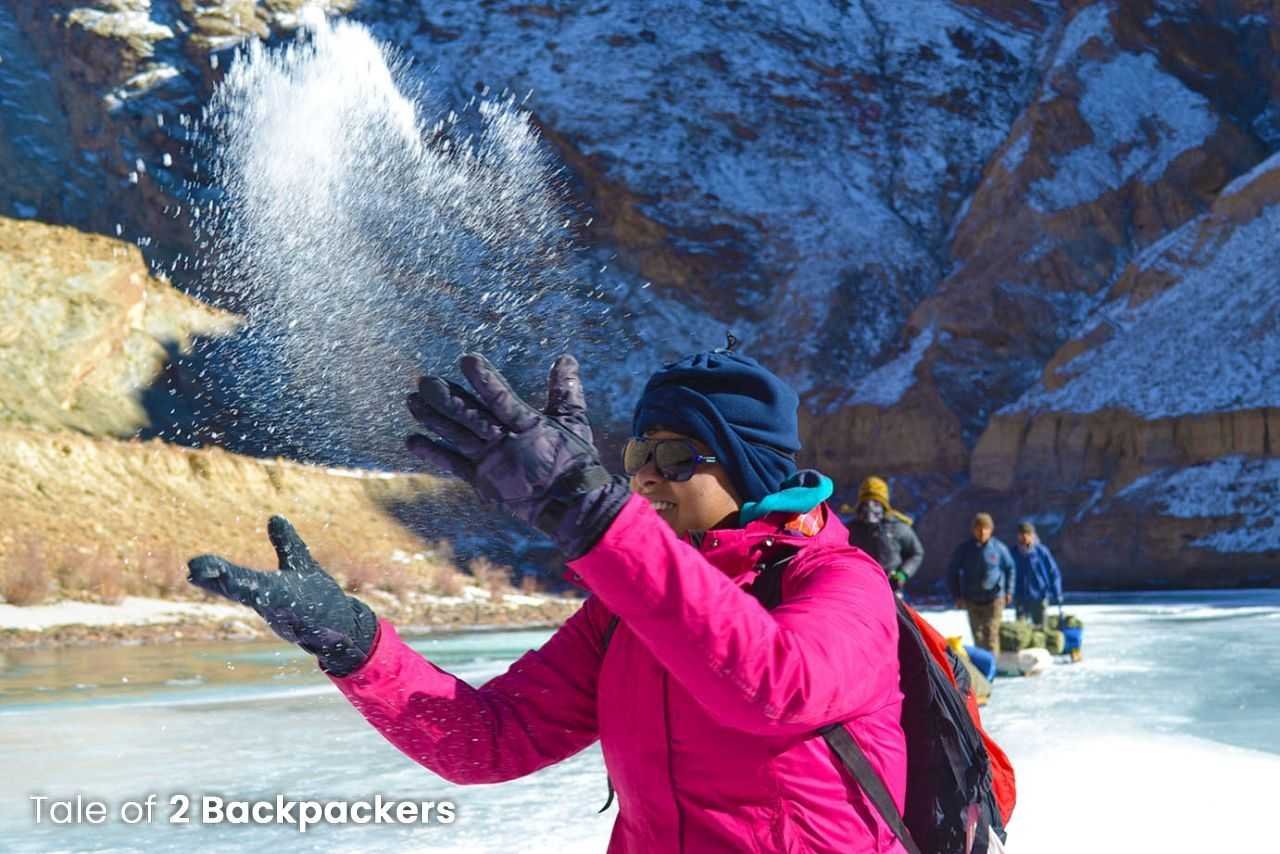
Chadar Trek was a changing point in a number of ways for me. The first thing that I realized on the trek was that we take nature around us so casually. We all are responsible in some ways or the other for environmental issues, either by using plastics or by our lifestyle or by some other reason. We might not be able to rectify all, but we can do whatever there is in our hands. Chadar Trek made me realize the importance of a responsible traveller, a responsible human being.
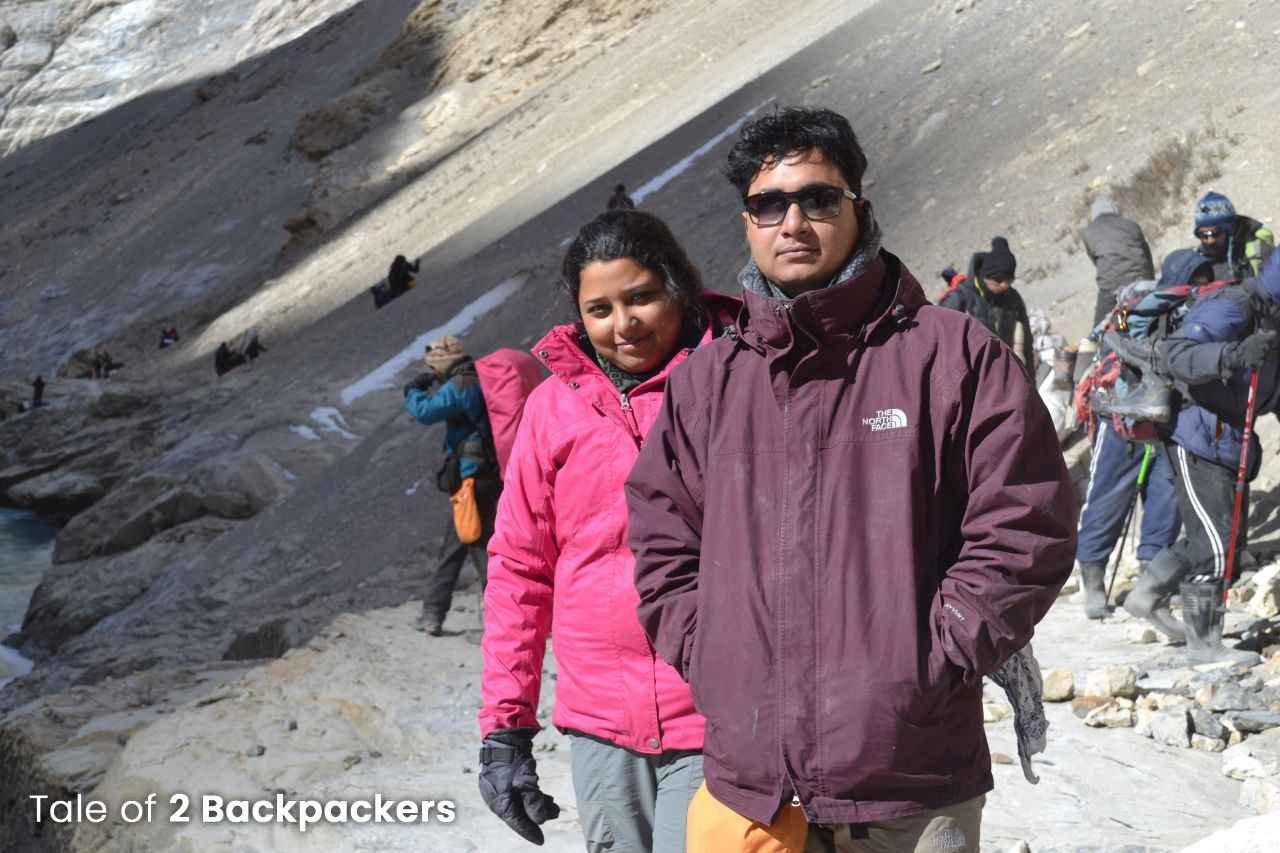
Chadar brought out the best and worst in me. In such harsh conditions, I found out my worst qualities as well as realized what I am capable of.
And the most important lesson that Chadar trek taught me is that everything in the world is ephemeral. Nothing lasts forever. Just as the Chadar is dynamic, changing its shape and course all the time, life too is not meant to be lived confined. Challenges are a part of life and are meant to be met with a smile on face and determination in the heart.
Have you done the Chadar Trek? How was your experience? Let us know in comments below. If you want to know anything else about the trek, please ask in comments below or send us a mail.
Pin this for a later read!






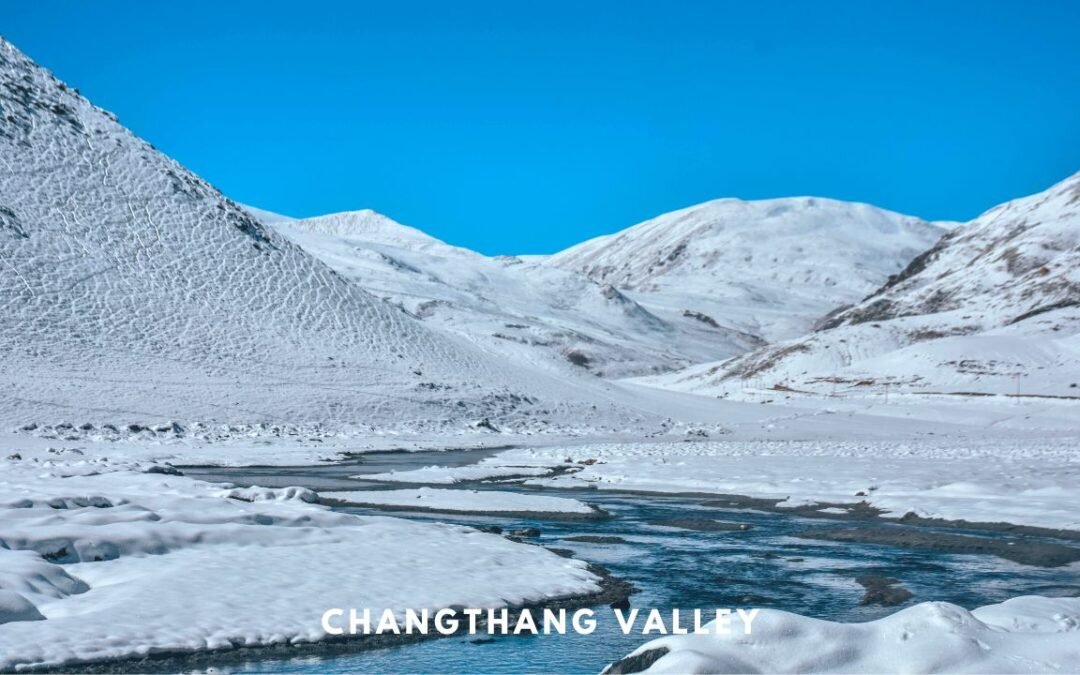



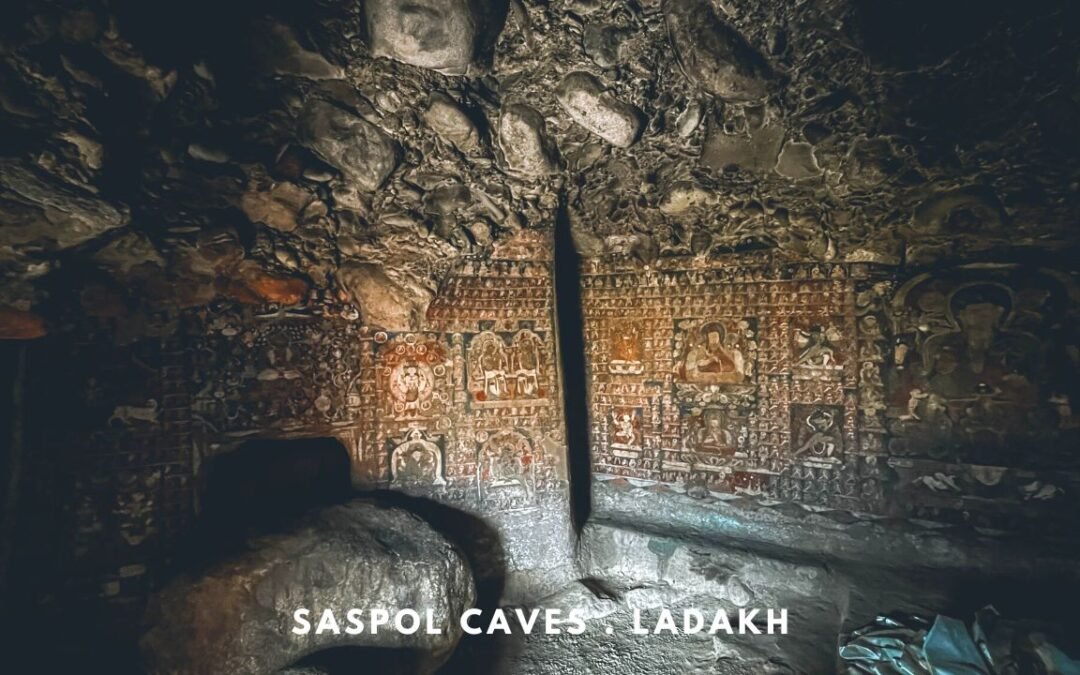
Your pictures bring your experience alive. Have heard so much about Chadar and after seeing your post, want to head there now.
Thanks Ami… Chadar is definitely an experience…
I really enjoy to read your Chadar Trek diary, it also encouraging me to do this trek in the future.
Thank you so much. Glad that we could inspire you!
I love reading your final thoughts after the trek that everything in the world doesn’t last forever and I totally agree with you. Thats why we should appericate everything we have and try not to ruin it. Also I would love to do this trek, it looks amazing (and a bit cold). 🙂 I would seriously consider doing is trek if I was in the Leh area, it is on the plans but I havent chosen which hiking trails I would like to do. My time will come.
Thank you Danik. It was really cold there. 🙂
This adventure looks so cold! And amazing! I haven’t done a trekking adventure yet and I’m not sure it is on my bucket list. I am more into long distance cycling!
Yes, it was cold! But was also beautiful.
What a great post! I admire your strength for being able to do this trek! As a Canadian, I understand how cold those temperatures can feel and cannot even imagine trekking and sleeping outside in those conditions. I’m very impressed! Nerak looks so beautiful and would be the place I would be most excited to visit. I also appreciate that you pointed gave tips on how to be a responsible traveller and not abuse the natural landscape!
Thank you Erica.
I can not even imagine walking on a frozen lake for 8 hours. AND it isn’t completely frozen. Isn’t there some rule about it needing to be completely frozen to a certain depth before walking on it? And having ice frozen on your nose when you wake up cannot be healthy. I obviously have anxiety issues, I would have been scared too. All that being said, it is beautiful. And you didn’t die. And this is a huge accomplishment!!!
I can totally understand your anxiety. I too was scared before going for the trek. But it went on well and we were back all hale and hearty.Yes there are rules about walking on frozen rivers. The guides look after that.
I am enjoying reading all about your hikes in the Himalayan Mountains. I may never get to do these myself. So it is interesting to read about ones like the Chadar Trek. Even as a Canadian I am a winter wimp. So walking on a frozen river at such cold temperatures would not be my kind of thing. Although I can see why the beauty would drive you to want to visit. What an adventure you had!
Thanks Linda. I am also not particularly fond of very cold. But Chadar trek experience was totally out of the world.
Amrita, I am overwhelmed with admiration for your perseverance, fortitude, and endurance! I was near tears just reading about your Chadar Trek experience in Ladakh and the many challenges you faced. I cannot imagine waking up with ice on my face and hair and slogging through frigid water, let alone navigating the mountain ledges. You must feel so accomplished and now have yet another amazing experience in your memory to draw should you ever face difficult times. (If you can do this, I believe you can do anything.) I am in awe of you.
I would love to have seen snow leopard tracks and that beautiful frozen waterful first hand. While you provided really important tips for anyone attempting this trek, I am grateful to have seen both wonders–along with many other natural beauties–through your eyes.
Thank you so much Jackie for your words. This means a lot to me as I am one of your admirers. Thanks again.
The thought of walking on a frozen river at almost 11,000ft for about 8 hours a day would intimidate me too! After reading your post I believe you that the Chadar Frozen River Trek is the most challenging in India. I bet you feel so accomplished now! I love reading about difficult hikes like this, but they are not for me! Waking up with ice on my nose, no thanks….lol.
Thank you Elizabeth. Yes, Chadar Trek is one of the most challenging treks in India. I would not say the most challenging!
Just reading the first para about the altitude and temperature and time, it already sounds exhausting. So, super congratulations for completing the trek inspite of these harsh realities!!! You’ve been to Roopkund already? Whoa! Hats off to you!!!!
//Ice frozen on the hair on my nose// – What???? OMG! That’s brrrrrrrrrrrrrrrr cold!
I have never walked on thin ice or frozen river so far, and I can’t imagine how would it be to do it all day long for days together!
The frozen waterfalls of Nerak looks so so so splendid!
Haha! I liked the way you described the experience about ice on hair and nose! Chadar Trek is a really an experience.
Wow that trek looks very intense. I love hiking and have done many multi day treks but nothing like that. I am not a fan of the cold and I can’t imagine hiking in those temperatures!! Your pictures though are amazing and it is certainly a challenge I could be tempted to do one day!!
Thank you Clare. The trek was a test to my perseverance and will power!
Fantastic post. Your narration was so beautiful. Do we have a satellite phone facility during the trek?
Thank you so much. Glad that you liked the article. Yes, there will be satellite phones with your trek leaders.
Hi,
I am planning to do the trek in Jan 2022 and just happened to check your post today. Ideally, how many months should one book this trek in advance ? it is just the beginning of winter so would it be fine to book now or one should wait for some more time and then go ahead based on the winter conditions on leh. what do you suggest ?
Assuming that you are trek fit, you can book the trek even 15 days before. But please be sure of your fitness and learn about winter conditions in Ladakh if you plan to do this trek. email us if you have any more queries. Thanks and have a great trekking experience.
Really loved your honest and fantastic narration of the Chader trek. I have been waiting to do this since a couple of years and I am finally planning to do this in Jan 2024. I will be traveling solo, and wanted to ask you about any good trekking group which cater for women trekkers as well, cause there are so many, and it’s difficult to understand which ones are actually good.
Many thanks for this lovely post I really enjoyed reading it.
Thank you so much! We are so glad that you are doing the Chadar Trek. It is a lifetime experience for sure. You can do the trek from any reputed trekking companies in India. We did it with Indiahikes. Thanks again.